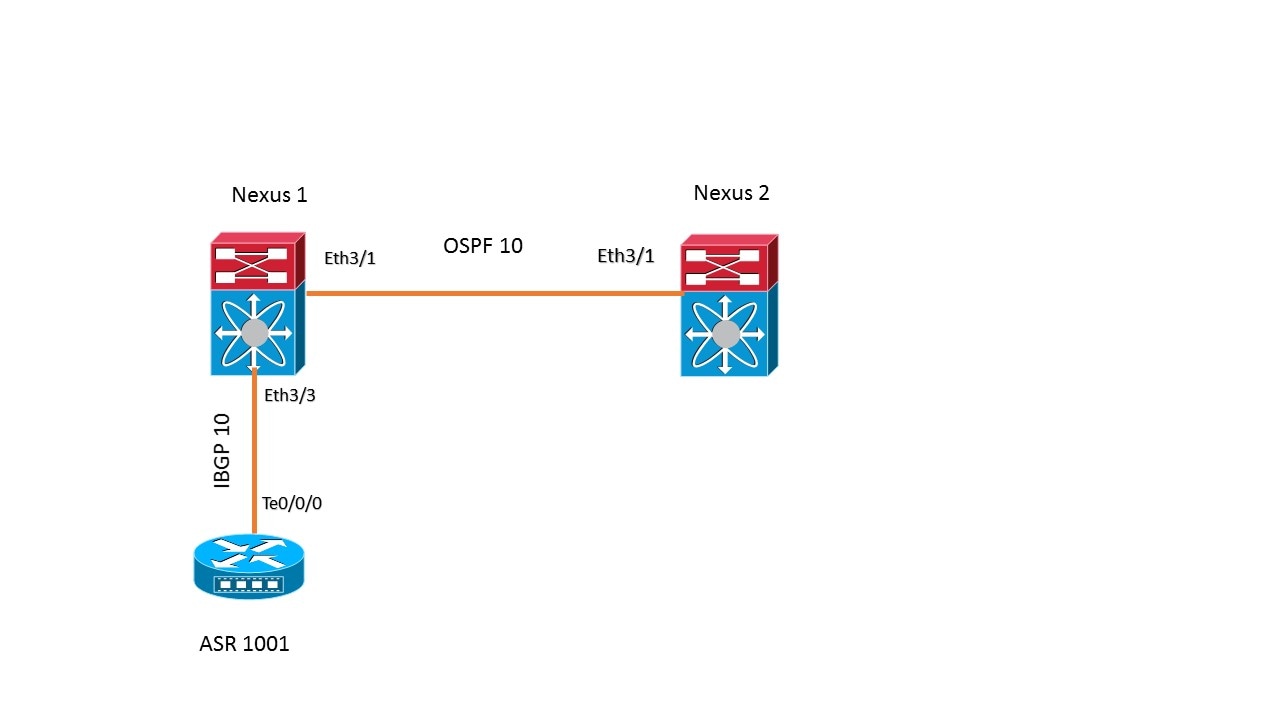Introducción
Este documento describe el método para redistribuir la ruta iBGP (Internal Border Gateway Protocol) en OSPF(Open Shortest Path First ) en las plataformas Nexus.
Prerequisites
Requirements
Cisco recomienda que tenga conocimientos básicos sobre BGP(protocolo de gateway fronterizo) y Protocolos de ruteo OSPF.
Componentes Utilizados
Este documento está restringido al software NX-OS y a la familia de switches Nexus.
The information in this document was created from the devices in a specific lab environment. All of the devices used in this document started with a cleared (default) configuration. If your network is live, make sure that you understand the potential impact of any command.
Antecedentes
En la plataforma Nexus, cuando se realiza la redistribución del protocolo BGP al protocolo OSPF, de forma predeterminada sólo se redistribuyen las rutas EBGP. Para redistribuir las rutas BGP internas, se debe configurar un route-map y aplicarlo en el comando redistribute bajo la configuración OSPF.
Configurar
Diagrama de la red
La siguiente imagen se utilizaría como topología de ejemplo para el resto del documento.

En esta topología de ejemplo, la vecindad OSPF se configura entre los dos dispositivos Nexus. El router ASR1001 está teniendo un par iBGP con Nexus 1. Nexus 1 aprende el prefijo 192.168.1.0/24 de ASR 1001 a través de iBGP que se redistribuye en el proceso OSPF 10 para ser enviado a Nexus 2.
ASR1001
A continuación se muestra la configuración en el router ASR1001:
!
interface Loopback0
ip address 192.168.1.1 255.255.255.0
!
interface TenGigabitEthernet0/0/0
ip address 10.10.12.1 255.255.255.0
!
router bgp 10
bgp log-neighbor-changes
network 192.168.1.0
neighbor 10.10.12.2 remote-as 10
!
Nexus1
feature ospf
feature bgp
!
ip prefix-list iBGP2OSPF seq 5 permit 192.168.1.0/24
route-map iBGP2OSPF permit 10
match ip address prefix-list iBGP2OSPF
match route-type internal ---------> This command redistributes iBGP routes
!
!
interface Ethernet3/1
ip address 10.10.23.2/24
ip router ospf 10 area 0.0.0.0
no shutdown
!
interface Ethernet3/3
ip address 10.10.12.2/24
no shutdown
!
router ospf 10
router-id 2.2.2.2
redistribute bgp 10 route-map iBGP2OSPF
!
router bgp 10
neighbor 10.10.12.1 remote-as 10
address-family ipv4 unicast
!
Nexus2
!
feature ospf
feature bgp
!
interface Ethernet3/1
ip address 10.10.23.3/24
ip router ospf 10 area 0.0.0.0
no shutdown
!
!
router ospf 10
router-id 3.3.3.3
no system auto-upgrade epld
!
Verificación
Estas secciones describen el resultado del prefijo en Nexus1 y Nexus2 antes y después de aplicar el comando "match route-type internal".
Antes De Aplicar El Comando "Match Route-Type Internal"
El prefijo 192.168.1.0/24 aprendió en Nexus 1 desde ASR1001 a través de iBGP .
Nexus1# sh ip bgp
BGP routing table information for VRF default, address family IPv4 Unicast
BGP table version is 4, local router ID is 10.10.12.2
Status: s-suppressed, x-deleted, S-stale, d-dampened, h-history, *-valid, >-best
Path type: i-internal, e-external, c-confed, l-local, a-aggregate, r-redist, I-i
njected
Origin codes: i - IGP, e - EGP, ? - incomplete, | - multipath, & - backup
Network Next Hop Metric LocPrf Weight Path
*>i192.168.1.0/24 10.10.12.1 0 100 0 i
Según la siguiente configuración en Nexus1, la ruta iBGP se redistribuye en el proceso OSPF 10 .
!
router ospf 10
router-id 2.2.2.2
redistribute bgp 10 route-map iBGP2OSPF
!
Aquí el route-map no tiene el statemanet "match route-type internal". Como se muestra a continuación, el prefijo 192.168.1.0/24 no se encuentra en la tabla de ruteo de Nexus 2.
Nexus2# show ip route 192.168.1.0
IP Route Table for VRF "default"
'*' denotes best ucast next-hop
'**' denotes best mcast next-hop
'[x/y]' denotes [preference/metric]
'%<string>' in via output denotes VRF <string>
Route not found
Además, el prefijo 192.168.1.0/24 no está disponible en la base de datos OSPF en Nexus 1.
Nexus1# show ip ospf database external 192.168.1.0
OSPF Router with ID (2.2.2.2) (Process ID 10 VRF default)
Después De Aplicar El Comando "Match Route-Type Internal"
La sentencia "match route-type" se agrega ahora al route-map iBGP2OSPF:
!
route-map iBGP2OSPF permit 10
match ip address prefix-list iBGP2OSPF
match route-type internal
!
Después de agregar el estado, el resultado en Nexus1 muestra que el prefijo 192.168.1.0/24 está presente en la base de datos OSPF.
Nexus1# show ip ospf database external 192.168.1.0
OSPF Router with ID (2.2.2.2) (Process ID 10 VRF default)
Type-5 AS External Link States
Link ID ADV Router Age Seq# Checksum Tag
192.168.1.0 2.2.2.2 20 0x80000002 0xa6ad 10
La ruta 192.168.1.0/24 está ahora presente en la tabla de ruteo de Nexus2 como se esperaba:
Nexus2# show ip route 192.168.1.0
IP Route Table for VRF "default"
'*' denotes best ucast next-hop
'**' denotes best mcast next-hop
'[x/y]' denotes [preference/metric]
'%<string>' in via output denotes VRF <string>
192.168.1.0/24, ubest/mbest: 1/0
*via 10.10.23.2, Eth3/1, [110/1], 00:01:11, ospf-10, type-2, tag 10
